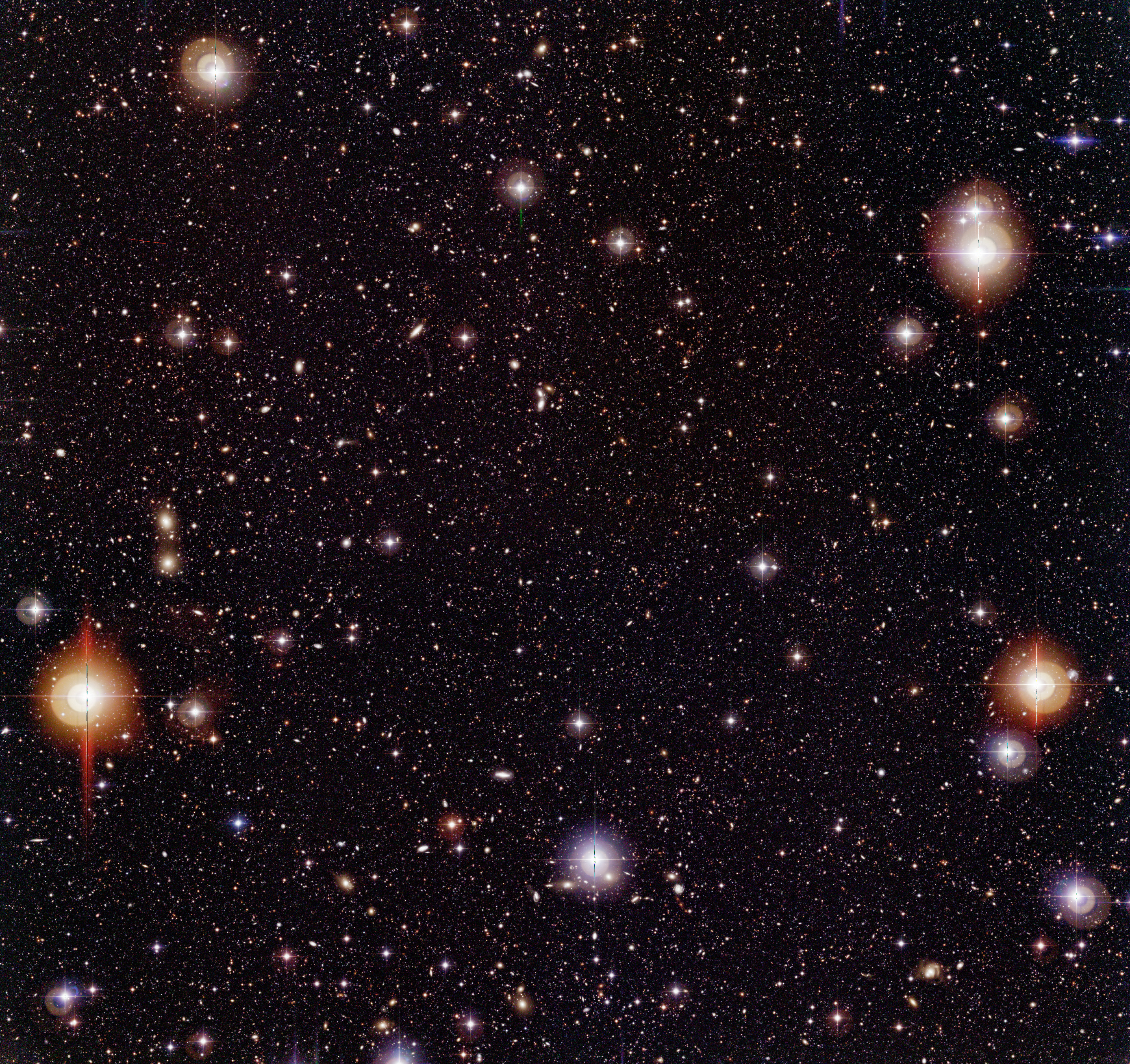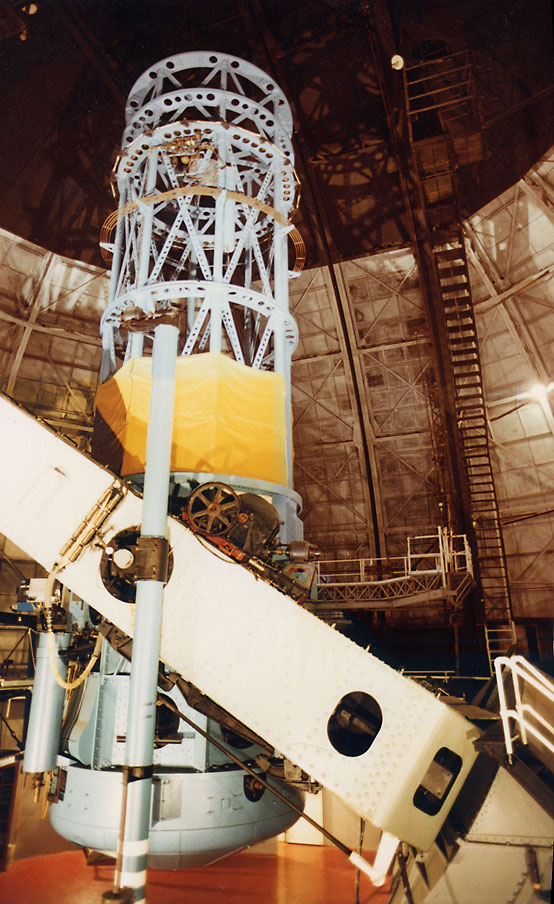|
Visible Multi Object Spectrograph
The Visible Multi-Object Spectrograph (VIMOS) is a wide field imager and a multi-object spectrograph installed at the European Southern Observatory's Very Large Telescope (VLT), in Chile. The instrument used for deep astronomical surveys delivers visible images and spectra of up to 1,000 galaxies at a time. VIMOS images four rectangular areas of the sky, 7 by 8 arcminutes each, with gaps of 2 arcminutes between them. Its principal investigator was Olivier Le Fèvre. The Franco-Italian instrument operates in the visible part of the spectrum from 360 to 1000 nanometers (nm). In the conceptual design phase, the multi-object spectrograph then called VIRMOS included an additional instrument, NIMOS, operating in the near-infrared spectrum of 1100–1800 nm. Operating in the three different observation modes, direct imaging, multi-slit spectroscopy, and integral field spectroscopy, the main objective of the instrument is to study the early universe through massive redshift surve ... [...More Info...] [...Related Items...] OR: [Wikipedia] [Google] [Baidu] |
Chandra Deep Field South
The Chandra Deep Field South (CDF-S) is an image taken by the Chandra X-ray Observatory satellite. The location was chosen because, like the Lockman Hole, it is a relatively clear "window" through the ubiquitous clouds of neutral hydrogen gas in the Milky Way galaxy, which allows observers to clearly see the rest of the universe in X-rays. The image is centered on RA DEC (J2000.0), covering 0.11 square degrees, measuring 16 arcminutes across. This patch of sky lies in the Fornax constellation. The image was created by compositing 11 individual ACIS-I exposures for a cumulative exposure time of over one million seconds, in the period 1999–2000, by a team led by Riccardo Giacconi. This region was selected for observation because it has much less galactic gas and dust to obscure distant sources. Further observations taken between 2000 and 2010 have resulted in a total of exposure of over four million seconds. An additional four million seconds of exposure are scheduled to be u ... [...More Info...] [...Related Items...] OR: [Wikipedia] [Google] [Baidu] |
Telescope Instruments
A telescope is a device used to observe distant objects by their emission, absorption, or reflection of electromagnetic radiation. Originally meaning only an optical instrument using lenses, curved mirrors, or a combination of both to observe distant objects, the word ''telescope'' now refers to a wide range of instruments capable of detecting different regions of the electromagnetic spectrum, and in some cases other types of detectors. The first known practical telescopes were refracting telescopes with glass lenses and were invented in the Netherlands at the beginning of the 17th century. They were used for both terrestrial applications and astronomy. The reflecting telescope, which uses mirrors to collect and focus light, was invented within a few decades of the first refracting telescope. In the 20th century, many new types of telescopes were invented, including radio telescopes in the 1930s and infrared telescopes in the 1960s. Etymology The word ''telescope ... [...More Info...] [...Related Items...] OR: [Wikipedia] [Google] [Baidu] |
Astronomical Instruments
Astronomical instruments include: *Alidade *Armillary sphere * Astrarium *Astrolabe *Astronomical clock *the Antikythera mechanism, an astronomical clock *Blink comparator *Bolometer *the Canterbury Astrolabe Quadrant *Celatone *Celestial sphere *Charge-coupled device * Computers *CMOS sensor *Coronagraph * Cosmolabe *Dioptra * Equatorial ring * Equatorium *Gnomon *Inclinometer *Interferometer * Kamal *Meridian circle * Microchannel plate detector * Mural instrument * Nebra sky disk *Nocturnal * Octant *Optical spectrometer, a.k.a., Spectrograph *Orrery *Photographic plate *Photometer *Planisphere *the Prague astronomical clock * Quadrant *Reticle * Radio plate *Retroreflector * Scaphe *Sextant *Starshade *Space telescope *Spectrometers *Sundial *Telescope * Torquetum * Triquetrum *Zenith telescope See also *Astronomy * Outline of astronomy * Surveying instrument *Measurement instrument {{DEFAULTSORT:Astronomical instruments Instruments Instrument may refer to: Science a ... [...More Info...] [...Related Items...] OR: [Wikipedia] [Google] [Baidu] |
List Of Instruments At The Very Large Telescope
The Very Large Telescope (VLT) is a telescope facility operated by the European Southern Observatory on Cerro Paranal in the Atacama Desert of northern Chile. It consists of four individual telescopes, each with a primary mirror 8.2 m across, which are generally used separately but can be used together to achieve very high angular resolution. The four separate optical telescopes are known as ''Antu'', ''Kueyen'', ''Melipal'', and ''Yepun'', which are all words for astronomical objects in the Mapuche language. The telescopes form an array complemented by four movable Auxiliary Telescopes (ATs) of 1.8 m aperture. The VLT operates at visible and infrared wavelengths. Each individual telescope can detect objects roughly four billion times fainter than can be detected with the naked eye, and when all the telescopes are combined, the facility can achieve an angular resolution of about 0.002 arcsecond. In single telescope mode of operation angular resolution is about 0.05 arcsec ... [...More Info...] [...Related Items...] OR: [Wikipedia] [Google] [Baidu] |
Cosmic Evolution Survey
The Cosmic Evolution Survey (COSMOS) is a Hubble Space Telescope (HST) Treasury Project to survey a two square degree equatorial field with the Advanced Camera for Surveys (ACS). The largest survey ever undertaken by HST, the project incorporates commitments from observatories around the world, such as the Very Large Array radio observatory, the European Space Agency's XMM-Newton satellite, and Japan's eight meter Subaru telescope. At the moment, more than 150 astronomers around the world actively contribute to the project. The project's primary goal is to study the relationship between large scale structure (LSS) in the universe and dark matter, the formation of galaxies, and nuclear activity in galaxies. This includes careful analysis of the dependence of galaxy evolution on environment. The survey covers a field, often known as the ''COSMOS field'', of 2 square degrees of sky in the constellation Sextans. The centre of the field in j2000 coordinates is at Right Ascension ... [...More Info...] [...Related Items...] OR: [Wikipedia] [Google] [Baidu] |
Hyperion Proto-supercluster
The Hyperion proto-supercluster is the largest and earliest known proto-supercluster, 5,000 times the mass of the Milky Way and seen at 20% of the current age of the universe. It was discovered in 2018 by analysing the redshifts of 10,000 objects observed with the Very Large Telescope in Chile. Discovery The discovery was announced in late 2018. The discovery team led by Olga Cucciati used computational astrophysics methods and astroinformatics; statistical techniques were applied to large datasets of galaxy redshifts, using a two-dimensional Voronoi tessellation to correlate gravitational interaction ( virialization) of visible structures. The existence of non-visible (dark matter) structures was inferred. Correlation was based on redshift data captured in a sky survey called VIMOS-VLT Deep Survey, using the Visible Multi Object Spectrograph (VIMOS) instrument of the Very Large Telescope in Chile, and other surveys to a lesser extent. Spectroscopic redshift data for 3,822 obj ... [...More Info...] [...Related Items...] OR: [Wikipedia] [Google] [Baidu] |
SN 2006X
SN 2006X was a Type Ia supernova about 65 million light-years away in Messier 100, a spiral galaxy in the constellation Coma Berenices. The supernova was independently discovered in early February 2006 by Shoji Suzuki of Japan and Marco Migliardi of Italy Italy ( it, Italia ), officially the Italian Republic, ) or the Republic of Italy, is a country in Southern Europe. It is located in the middle of the Mediterranean Sea, and its territory largely coincides with the homonymous geographical re .... SN 2006X is particularly significant because it is a Type Ia supernova. These supernovae are used for measuring distances, so observations of these supernovae in nearby galaxies are needed for calibration. SN 2006X is located in a well-studied galaxy, and it was discovered two weeks before its peak brightness, so it may be extraordinarily useful for understanding supernovae and for calibrating supernovae for distance measurements. It may even be possible to identify the ... [...More Info...] [...Related Items...] OR: [Wikipedia] [Google] [Baidu] |
Messier 100
Messier 100 (also known as NGC 4321) is a grand design intermediate spiral galaxy in the southern part of the mildly northern Coma Berenices. It is one of the brightest and largest galaxies in the Virgo Cluster and is approximately 55 million light-years from our galaxy, its diameter being 107,000 light years, and being about 60% as large. It was discovered by Pierre Méchain in 1781 and 29 days later seen again and entered by Charles Messier in his catalogue "of nebulae and star clusters". . It was one of the first spiral galaxies to be discovered, and was listed as one of fourteen spiral nebulae by Lord William Parsons of Rosse in 1850. NGC 4323 and NGC 4328 are satellite galaxies of M100; the former is connected with it by a bridge of luminous matter. Early observations After the discovery of M100 by Méchain, Charles Messier made observations of the galaxy depicting it as a nebula without a star. He pointed out that it was difficult to recognize the nebula because of ... [...More Info...] [...Related Items...] OR: [Wikipedia] [Google] [Baidu] |
NGC 6118
NGC 6118 is a grand design spiral galaxy located 83 million light-years away in the constellation Serpens (the Snake). It measures roughly 110,000 light-years across; about the same as our own galaxy, the Milky Way. Its shape is classified as " SA(s)cd," meaning that it is unbarred and has several rather loosely wound spiral arms. The large numbers of bright bluish knots are active star-forming regions where some very luminous and young stars can be perceived. Because NGC 6118 has loosely wound spiral open arms, no clear defined spiral arms like the Milky Way galaxy and lacks a central bar, the galaxy thus does not have a galactic habitable zone like the Milky Way. For the Milky Way, the galactic habitable zone is commonly believed to be an annulus with an outer radius of about 10 kiloparsecs and an inner radius close to the Galactic Center, both of which lack hard boundaries. NGC 6118 is difficult to see with a small telescope. Amateur astronomers have nicknamed it the "Blink ... [...More Info...] [...Related Items...] OR: [Wikipedia] [Google] [Baidu] |
Milky Way
The Milky Way is the galaxy that includes our Solar System, with the name describing the galaxy's appearance from Earth: a hazy band of light seen in the night sky formed from stars that cannot be individually distinguished by the naked eye. The term ''Milky Way'' is a translation of the Latin ', from the Greek ('), meaning "milky circle". From Earth, the Milky Way appears as a band because its disk-shaped structure is viewed from within. Galileo Galilei first resolved the band of light into individual stars with his telescope in 1610. Until the early 1920s, most astronomers thought that the Milky Way contained all the stars in the Universe. Following the 1920 Great Debate between the astronomers Harlow Shapley and Heber Curtis, observations by Edwin Hubble showed that the Milky Way is just one of many galaxies. The Milky Way is a barred spiral galaxy with an estimated D25 isophotal diameter of , but only about 1,000 light years thick at the spiral arms (more at the ... [...More Info...] [...Related Items...] OR: [Wikipedia] [Google] [Baidu] |



.jpg)

